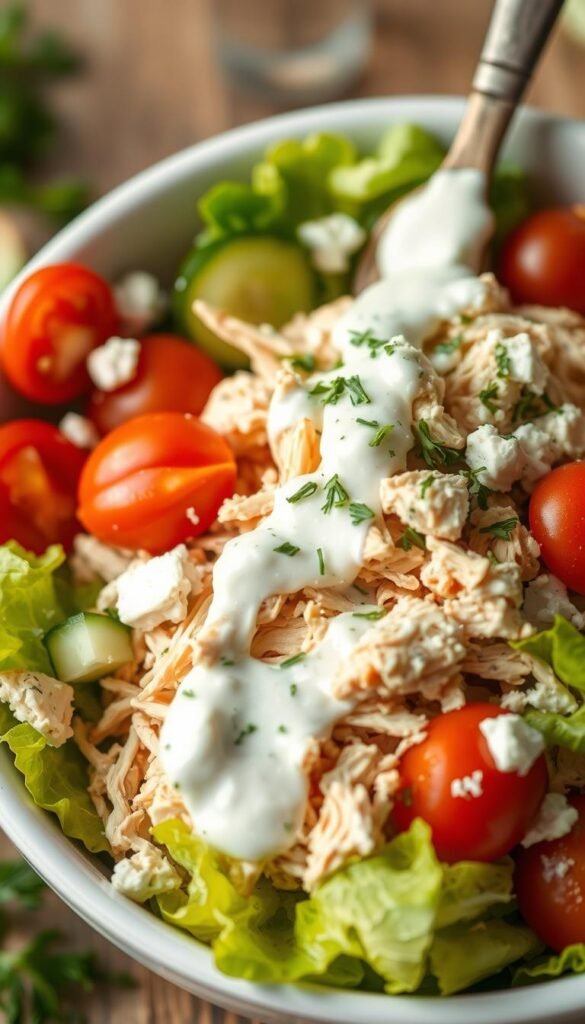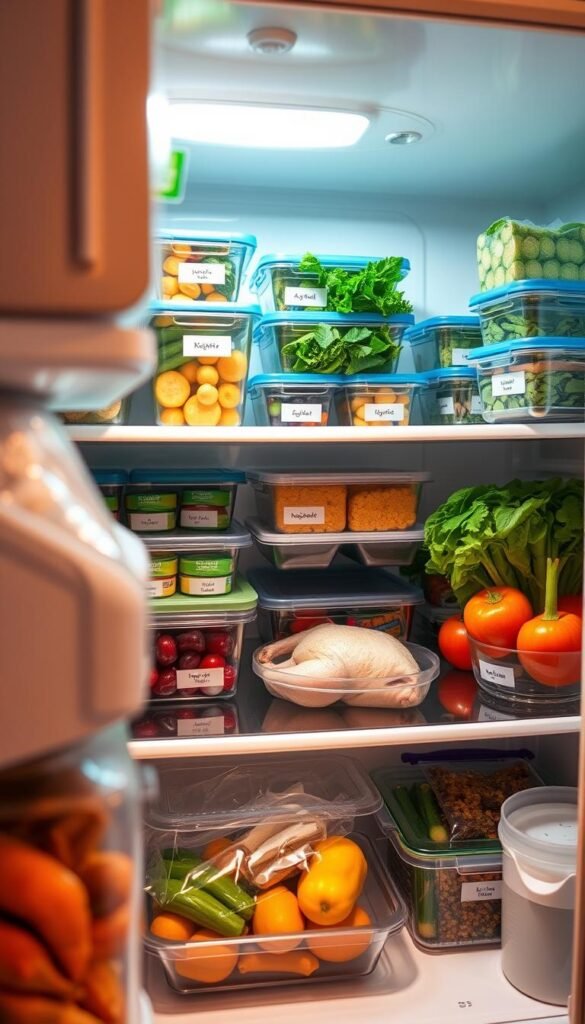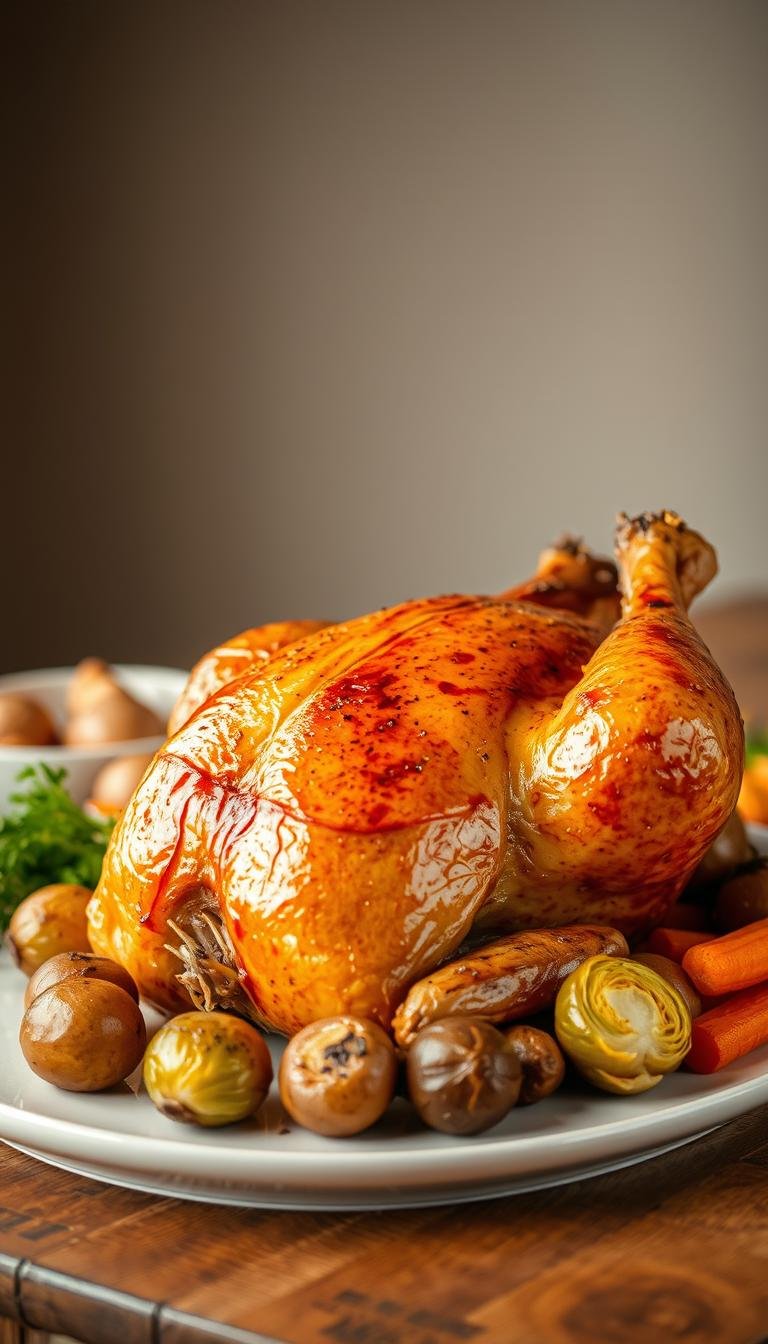Healthy Rotisserie Chicken Recipes for Quick Meals
Surprising fact: nearly 40% of home cooks reach for a store-bought roast to save time on weeknights — and for good reason.
This guide shows how a simple leftover bird can become high-protein dinners in minutes without losing flavor. You’ll find two go-to styles: a no-cook, 15-minute chicken salad and a veggie-loaded baked casserole that highlights fresh veggies and pantry staples.
Both options keep prep low, portions flexible, and results consistent whether you need one meal or a week of lunches. Expect smart swaps like Greek yogurt for creaminess and basic seasonings to boost flavor while keeping the dish protein-forward.
Each base can stretch multiple ways — sandwiches, bowls, or lettuce wraps — and scales easily from a cup of leftovers to a whole bird. Storage tips and mix-ins are included so repeats feel fresh and practical for busy schedules.
Key Takeaways
- Quick, protein-forward meals that come together in minutes.
- Two foundational styles: a 15-minute salad and a veggie casserole.
- Simple swaps (Greek yogurt, basic spices) keep flavor and texture.
- Flexible serving ideas: sandwiches, bowls, or low-carb wraps.
- Scales from a cup of leftovers to a full bird with easy storage tips.
Why rotisserie chicken makes healthy, quick meals right now
One supermarket purchase can cut weeknight cooking down to just a few minutes. A store-bought rotisserie chicken delivers fully cooked meat you can shred or dice and serve immediately. That simple swap turns dinner prep into an assembly task, not a cooking project.
Time-saving protein: from fridge to table in minutes
Pull, portion, and serve: a typical bird yields several cups of meat. That amount covers lunches and dinners for days or lets you batch a single pot and portion out meals.
Lean, protein base for veggie-packed plates
- Pre-cooked meat avoids raw handling and long oven or stovetop heat times, so newer cooks save time and effort.
- Consistent tenderness and seasoning mean it works in cold salads and quick bakes without extra fuss.
- Stretch cost and value by pairing the meat with vegetables, grains, and pantry staples for balanced plates with great flavor.
Plan ahead: shred the chicken as soon as you get home and refrigerate in portions. That way you can toss it into a pan, bowl, or wrap in minutes and skip lengthy reheating.
Smart swaps and staple ingredients for lighter flavor
Small swaps and reliable pantry staples let you keep bold flavor while cutting unnecessary fat and fuss. These choices make it simple to build quick meals with bright taste and less work.
Greek yogurt instead of heavy cream
Use plain greek yogurt to get creaminess plus extra protein. Brands like Fage Total or Trader Joe’s full-fat options hold up in casseroles and salads.
Swap tip: Mix a little milk with greek yogurt if you want a looser texture for dressings or a bake.
Pantry aromatics: olive oil, garlic, and onion
Start with a splash of olive oil and sauté onion and garlic for instant depth. Those aromatics let you use less cheese while keeping the dish savory.
Load up on spinach and other vegetables
Add volume with broccoli, cauliflower, or baby spinach to boost fiber and nutrients without extra fat. Vegetables make plates feel complete while stretching portions.
- Select plain yogurt to keep the base neutral; seasonings and meat carry the profile.
- A modest sprinkle of sharp cheddar goes far—use less cheese for big taste.
- Dried basil and parsley add steady flavor and are easy to store.
healthy rotisserie chicken recipes
Two simple formats keep weeknight prep fast and varied.
Quick salad (about 15 minutes): Toss shredded chicken with plain yogurt or a light mayo mix, add diced celery or apple, and fold in grapes or toasted nuts for crunch. Serve on bread, in a pita, or in lettuce cups for an easy lunch that scales by the cup.
Veggie-loaded casserole for make-ahead meals
The baked casserole blends chopped veggies, 3–4 cups of shredded meat, a touch of milk and eggs, and a small amount of sharp cheese for flavor. Bake until bubbly, then portion for dinners or grab-and-go lunches.
Mix-and-match add-ins
- Toasted nuts for texture; grapes or apple for sweet contrast.
- Spice blends (curry, smoked paprika, or za’atar) to shift the profile.
- Use sharp cheese sparingly to boost taste without overwhelming the dish.
Plan tip: Make a fresh salad now and a warm casserole for later in the week to stretch a whole bird into several satisfying meals.
15-minute rotisserie chicken salad with Greek yogurt
Ready in minutes: this 15-minute salad combines tender shredded meat with bright veg and a tangy yogurt-mayo dressing. It’s an easy base that scales from a single lunch to a week of portions.

Ingredients at a glance
- 2 cups chopped rotisserie chicken
- 1/3 cup mayonnaise + 1/3 cup Greek yogurt
- 1/3 cup finely diced celery
- 1/3 cup finely diced red onion
- 1/2 cup finely chopped baby spinach
- 1/2 teaspoon salt and 1/4 teaspoon black pepper
Method
Place all ingredients in a large bowl.
Season with salt and pepper, then stir until the mixture is creamy and even.
Chill briefly or serve right away on bread, in pita, with crackers, or in lettuce cups.
Make it yours
- Go low-fat: replace mayo with more yogurt.
- Dairy-free: use all mayo and skip yogurt.
- BBQ style: swap 2–3 tablespoons BBQ sauce for some mayo.
- Spicy: add chipotle-lime seasoning or a dash of cayenne; try a teaspoon then taste.
- Add texture: chopped nuts, apples, or grapes for sweet crunch.
Nutrition snapshot & serving
Servings: 6. Prep: 15 minutes. Each 1/2 cup serving is about ~165 calories.
Tip: Make a double batch and portion into containers for grab-and-go meals during the week.
Veggie-loaded rotisserie chicken casserole with Greek yogurt
A quick steam, a short sauté, and a single bake deliver a satisfying casserole that travels and reheats well.
Ingredients you’ll need
- 1 head broccoli (florets) and 1 head cauliflower (florets)
- 1 tbsp olive oil, 1/2 medium white onion (diced), 2–3 cloves garlic (minced)
- 2 heaping cups baby spinach, 2 eggs (whisked)
- 1 cup plain Greek yogurt, 1/4 cup 2% milk
- 1 1/2 cups sharp cheddar (shredded, divided)
- 3–4 cups pulled rotisserie chicken
- 1 tsp dried parsley, 1/2 tsp dried basil, 1/4 tsp red chili flakes, 1 tsp black pepper, 1 tsp fine sea salt
- 2/3 cup crushed parmesan crisps (for topping)
Method
Steam broccoli and cauliflower until just tender (about 15–18 minutes). Preheat oven to 375°F.
Sauté onion and baby spinach in olive oil over medium heat until the spinach wilts. Let vegetables cool slightly.
Whisk eggs, yogurt, and milk. Stir in 1 cup cheese, garlic, herbs, spices, and the pulled chicken. Fold in the cooked vegetables gently.
Spread evenly in a greased 9×13 dish. Top with remaining 1/2 cup cheese and crushed parmesan crisps. Bake about 35 minutes until golden; broil 2–3 minutes if you want extra crisp edges.
Shortcuts & tips
- Also use steamable frozen florets—thaw and drain well to avoid a watery bake.
- Swap toppings: crushed crackers, crispy fried onions, or breadcrumbs for crunchy contrast.
- The yogurt-based sauce controls fat while keeping a rich texture; sharp cheese boosts flavor so you can use less overall.
Serving ideas: from lettuce cups to crackers
A single scoop of salad can become several different lunches with tiny changes. Use simple swaps to turn the mix into a fast sandwich, a light plate, or a snackable bite. These ideas help you move through the week without getting bored.
Fast lunches: sandwiches, wraps, and pita pockets
To make a hearty handheld, spread the salad on toasted wheat or stuff it into pita pockets. Roll it into a large tortilla with extra spinach and tomato for a portable wrap that travels well.
Lighter plates: lettuce cups, cucumber slices, and tomato “bowls”
For lower carbs, spoon salad into crisp lettuce cups or onto cucumber rounds. Halved tomatoes or avocado halves work as quick bowls too.
- Pair a scoop with crackers for snackable crunch.
- Feel free to top servings with seeds, nuts, or fried onions for extra texture.
- You can also use spinach leaves as a base when you want more greens.
- Mix and match across meals to stretch one rotisserie bird into varied plates.
Texture and flavor boosters you can add in seconds
Add a quick layer of texture and flavor to any meal with just a few pantry items and a minute or two of chopping.
Fresh crunch
Start by adding a cup finely diced celery and red onion to lift brightness in cold salads or to scatter over warm bakes. Finely diced bits spread more evenly, so every bite has balance.
Seasonings to try
Keep a small spice kit: garlic, paprika, curry powder, and a touch of mustard form a quick backbone. Add basil and parsley to finish with herb lift. Begin with a single teaspoon of any new blend, then tweak salt and pepper slowly to avoid over-seasoning.
- Feel free to toss in extra veggies like diced bell pepper or shredded carrot for color and texture.
- Sprinkle nuts or seeds right before serving to preserve crunch.
- These boosters work across salad, casserole, and bowl formats and refresh a basic recipe fast.
| Booster | Best use | Start amount |
|---|---|---|
| Celery + red onion | Cold salads, toppings | 1 cup finely diced |
| Spice mix (garlic, paprika) | Warm bakes, dressings | 1 teaspoon |
| Basil & parsley | Finish for freshness | 1–2 tsp dried or 1 tbsp fresh |
| Nuts or seeds | Last-minute crunch | 2 tbsp, sprinkle |
Meal prep, storage, and reheating tips
Proper cooling, labeling, and portioning extend shelf life and make reheats predictable. Start by letting baked dishes cool before covering; trapping steam makes containers soggy and shortens fridge life.
Fridge life: store casserole and other cooked dishes in airtight containers in the fridge for 3–4 days. For salads that include yogurt and mayonnaise, keep them chilled and return leftovers to the fridge quickly.

Freezer and reheating guidance
Portion casseroles into individual cups or 2-cup trays before freezing so thawing and reheating are even. Freeze in airtight containers for 3–4 months.
Thaw frozen portions in the refrigerator for about 24 hours, then reheat in a preheated oven at 350°F. Smaller portions usually take 25–35 minutes to heat through; larger pans may need a bit longer.
Food safety and final tips
- Cool first: let hot bakes come to near-room temperature (no more than 2 hours) before sealing.
- Label containers: write the recipe name and date on each package so you can rotate food efficiently.
- Keep toppings separate: store crunchy onions, crackers, and seeds apart and add them after reheating to preserve texture.
- Shred and portion: pull rotisserie chicken into measured cups and refrigerate immediately for fast assembly later.
| Item | Storage (fridge) | Freezer plan | Reheat |
|---|---|---|---|
| Yogurt-based salad | 3–4 days airtight | Not recommended for best texture | Serve cold; do not heat |
| Veggie casserole (whole) | 3–4 days covered | Freeze in 2-cup trays, 3–4 months | Thaw 24 hrs, heat 350°F 25–35 min |
| Portioned cups/slices | 3–4 days airtight | Freeze single cups for easy reheats | Reheat straight from thaw at 350°F |
| Shredded chicken (pulled) | 3–4 days in fridge | Freeze in labeled cups for 3–4 months | Heat gently or use cold in salads |
Nutrition notes and ingredient callouts
Understanding portion-level numbers makes it easier to meet daily targets. Below are simple takeaways to help you track macros and adjust flavors without extra work.
Protein-forward meals with balanced fat and carbs
The veggie-loaded casserole is protein-forward: one-sixth yields about 32.5g protein and ~335 calories with ~18g fat. The salad runs roughly 165 calories per 1/2 cup.
Greek-style yogurt adds creaminess and extra protein, while a small amount of sharp cheese boosts flavor so you can use less fat overall.
Automated nutrition is an estimate; ingredients and cups/teaspoons matter
Nutrition panels are automatic estimates. Brands, portion accuracy, and swaps change totals. Measure by cup and teaspoon when tracking macros or sodium.
- Vegetables add fiber and volume so portions feel hearty without many calories.
- Adjust salt to taste, especially with pre-seasoned meat or salty toppings.
- Swap whole-milk for 2% yogurt or lower-fat dairy to reduce fat and calories modestly.
| Item | Typical per serving | Why it matters |
|---|---|---|
| Veggie casserole (1/6) | ~335 kcal, 32.5g protein, 18g fat | High protein, good for post-workout or filling dinners |
| Chicken salad (1/2 cup) | ~165 kcal | Quick, low-calorie portion for sandwiches or snacks |
| Yogurt & cheese | Varies by type (whole vs 2%) | Controls creaminess and fat—choose based on goals |
Tools we love and affiliate disclosure
The right pan, spatula, and bowl turn a slow process into a quick assembly. A few durable tools make prep cleaner and results more reliable for both the salad and the baked casserole.
Essentials
- 9×13 baking dish (Pyrex): Heats evenly and cleans easily for dependable casserole bakes.
- High-heat spatula (Rubbermaid): Good for sautéing veg, folding yogurt-based sauce, and scraping pans without damage.
- Large mixing bowl: Streamlines combining salads or the casserole base and keeps mess to a minimum.
About this post
Note: this post may contain affiliate links. If you click and buy, the site may earn a small commission at no extra cost to you.
Why these tools matter: Reliable gear saves time, keeps texture consistent, and reduces cleanup. Investing in a few well-made items beats buying many single-use gadgets over time.
Conclusion
Lean on a ready bird and a tub of Greek yogurt to spin quick salads or a warm casserole any night.
Keep a few cups of pulled rotisserie chicken and plain yogurt in the fridge so a meal is minutes away. Measure by cup and teaspoon to repeat results and cut excess fat by adjusting salt slowly.
Finish with a pinch of pepper and a little sharp cheese on top for bold flavor. Add crackers or crisp toppings, or serve in lettuce cups for a lighter plate.
Quick tip: sauté onion and garlic in a splash of olive over medium heat before folding into the casserole for clean, even flavor. Now pick a way—stir up the salad or slide the casserole into the oven—and enjoy.






